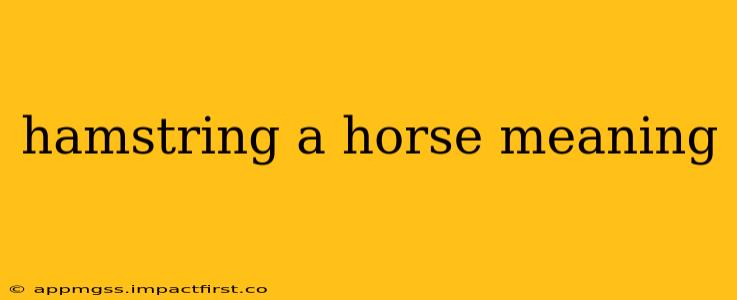The term "hamstring a horse" evokes a strong image, and understanding its meaning requires delving into both its literal and figurative interpretations. While the phrase might sound dramatic, its implications are significant, particularly in the context of animal welfare and equestrian practices.
What Does It Literally Mean to Hamstring a Horse?
Literally, to hamstring a horse means to sever or disable the hamstring tendons or muscles in the horse's hind legs. The hamstrings are a group of muscles located at the back of the thigh, crucial for locomotion and powerful hind leg movements. Severing these tendons severely impairs, and often completely prevents, the horse's ability to walk, run, or even stand properly. Historically, this act was used as a method of disabling or incapacitating a horse, rendering it useless for riding, warfare, or work. This act is cruel, inhumane, and illegal in most parts of the world.
Is Hamstringing a Horse Still Practiced?
While thankfully rare in modern times, hamstringing a horse is still sadly possible in some areas, largely due to malicious intent or criminal activity. In the past, it might have been used as a form of punishment, theft deterrence, or even warfare tactic. However, its extreme cruelty and illegality makes it a rare occurrence in the developed world. Those found guilty face severe penalties under animal cruelty laws.
What Does "Hamstring" Mean Figuratively?
Figuratively, "to hamstring" means to severely weaken, impede, or cripple something, often an organization, project, or effort. It implies a deliberate attempt to sabotage or undermine progress, leaving the subject significantly less effective.
Examples of Figurative Use:
- "The new regulations hamstrung the company's ability to expand." This signifies that the regulations created significant obstacles that significantly impaired their expansion efforts.
- "The lack of funding hamstrung the research project." In this context, the lack of funding severely limited their ability to progress and achieve their research goals.
- "Internal conflicts hamstrung the team's productivity." Here, the internal conflicts are hindering the team's overall efficiency and output.
Why is the Phrase So Powerful?
The powerful imagery of a horse, a symbol of strength and power, being rendered helpless and immobile highlights the severity of the act, both literally and figuratively. This makes the phrase effective in conveying the idea of complete incapacitation and the deliberate hindering of something's potential.
What are the Ethical Concerns Associated with the Literal Meaning?
The act of hamstringing a horse is inherently cruel and unethical. It causes immense pain and suffering to the animal, potentially leading to long-term disability or even death. The complete disregard for animal welfare involved is morally reprehensible. Any instance should be reported to the appropriate authorities.
This comprehensive exploration clarifies the meaning of "hamstring a horse," addressing both its literal cruelty and its widespread figurative application. Understanding the historical context and the ethical implications underscores the seriousness of the term.
